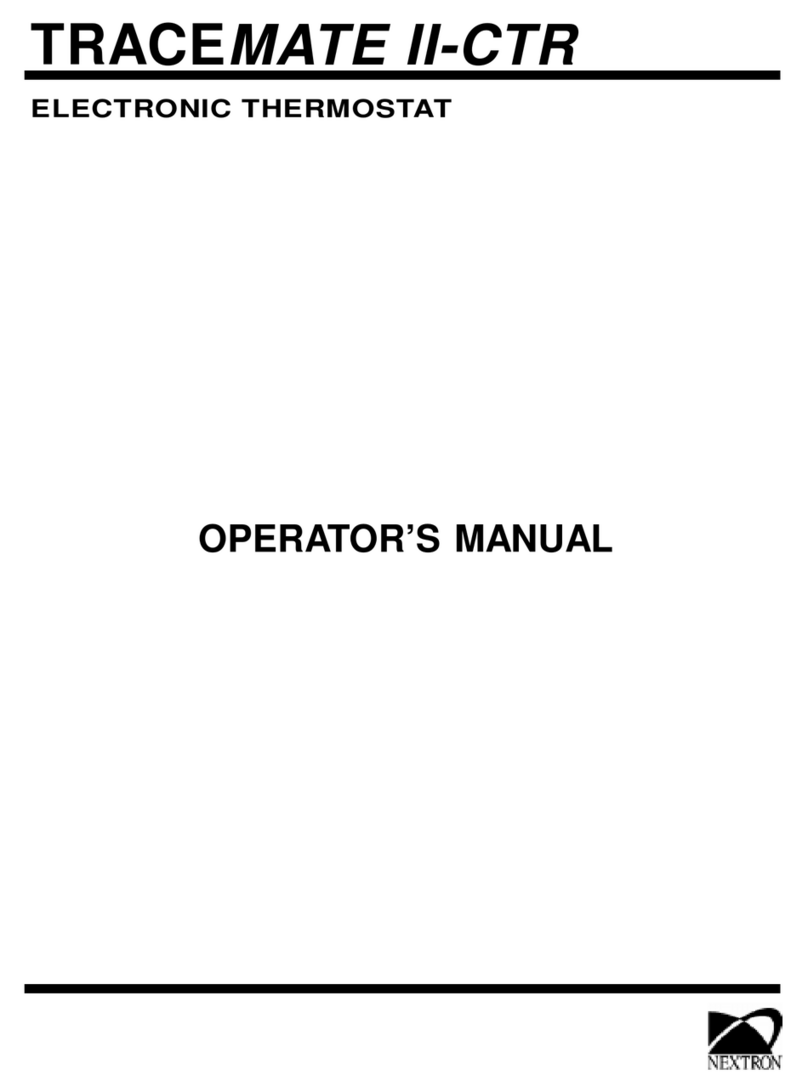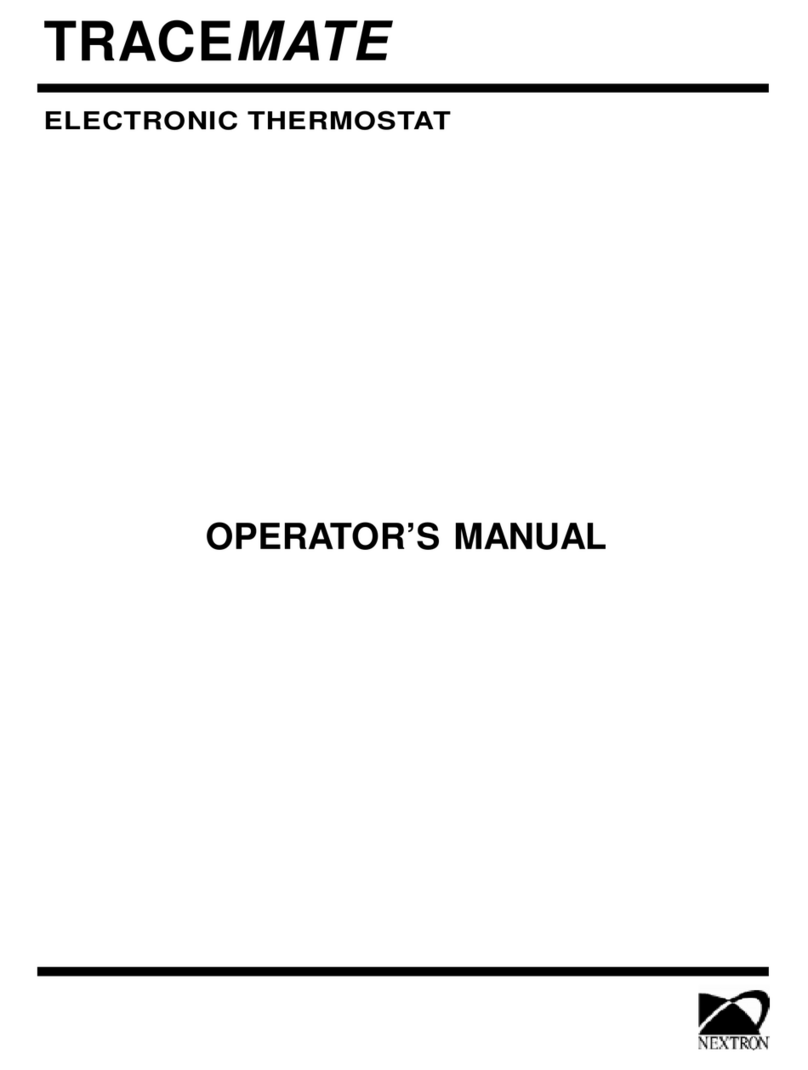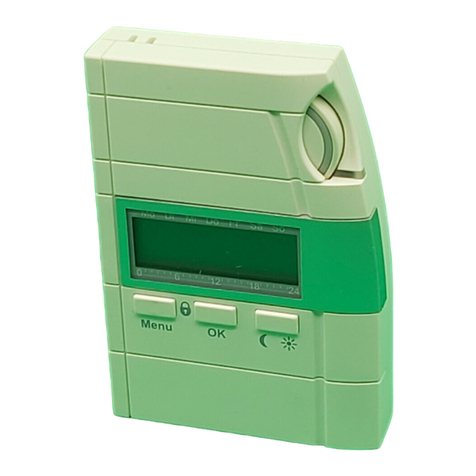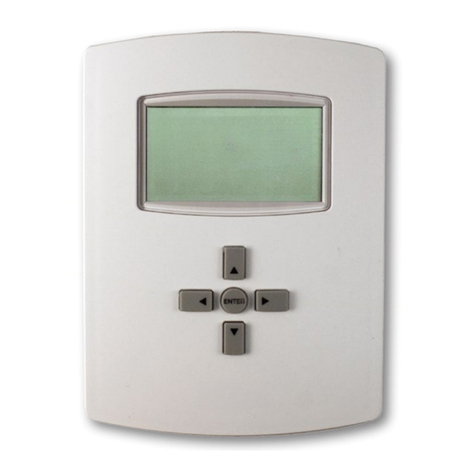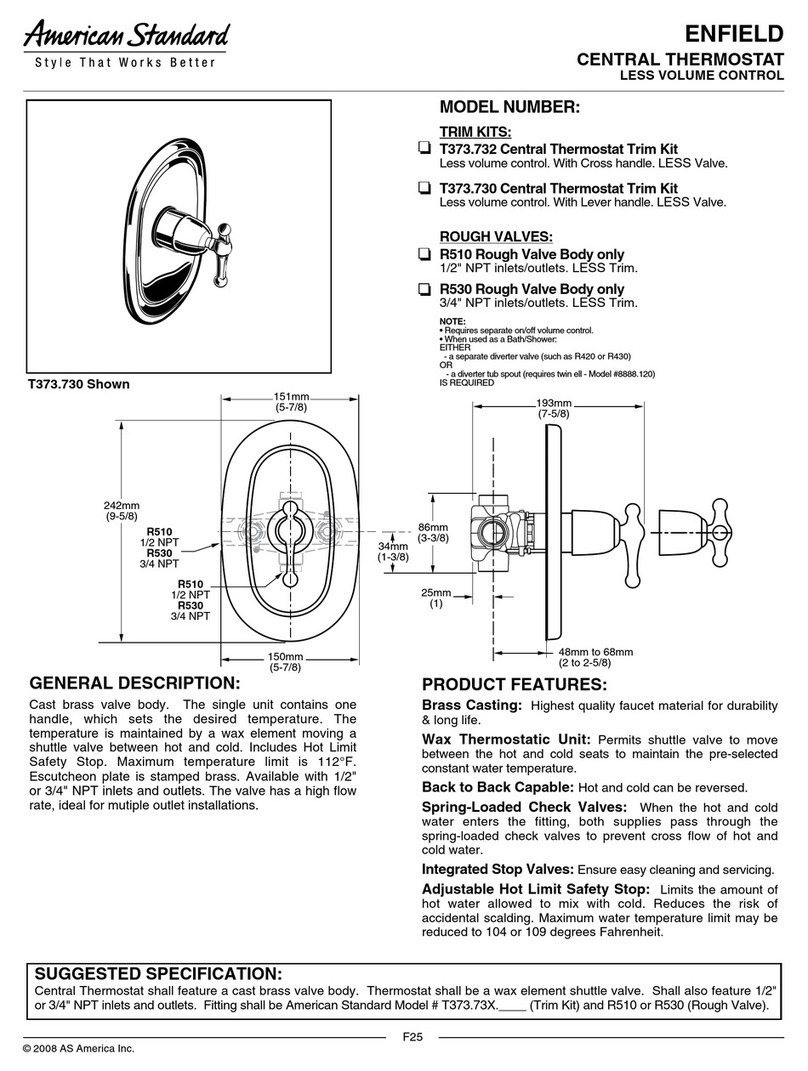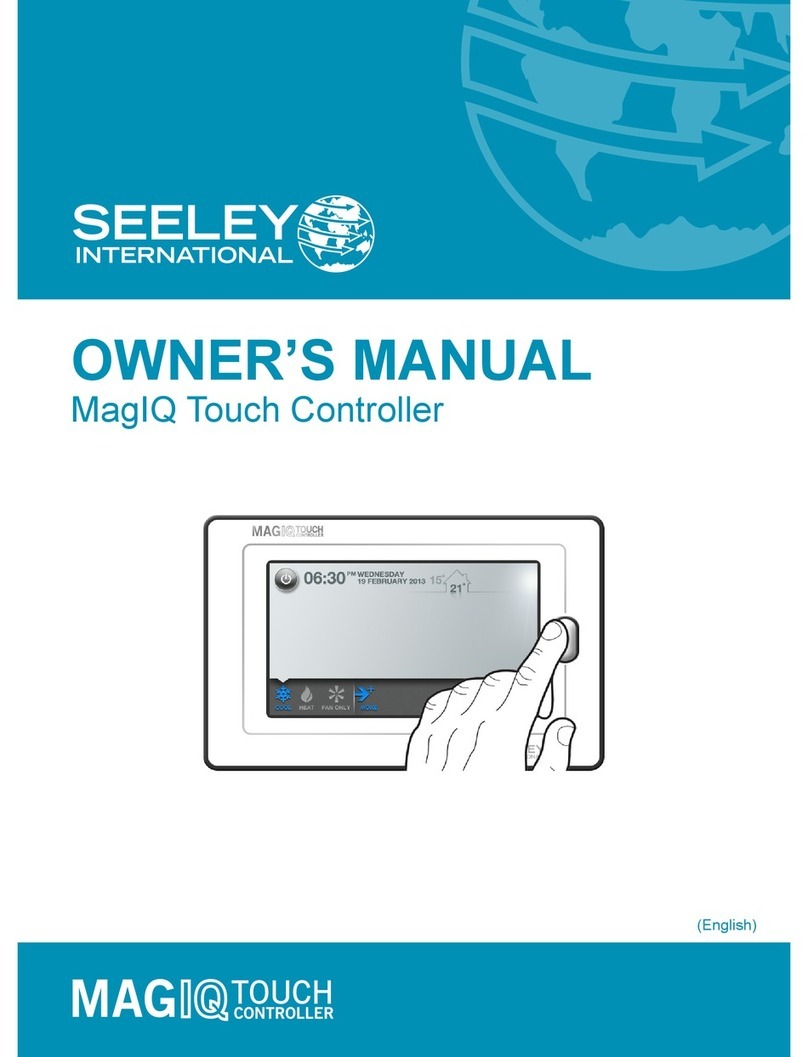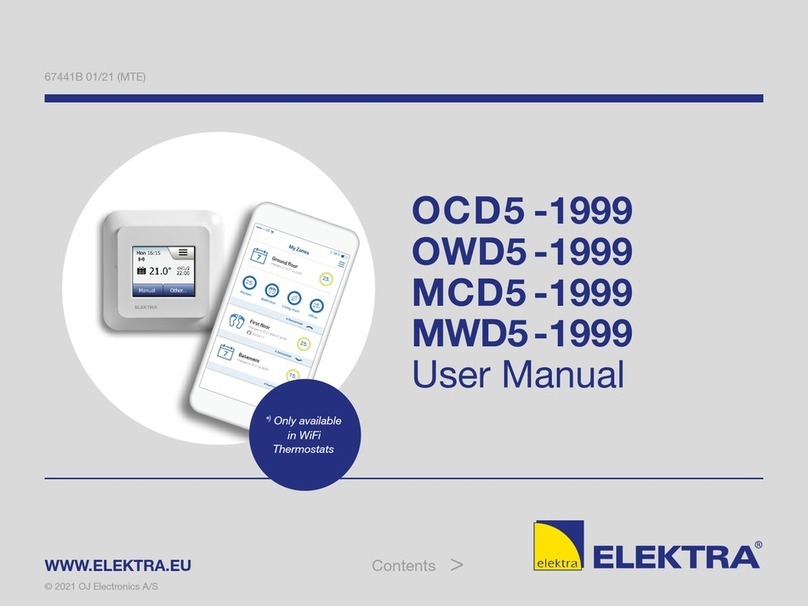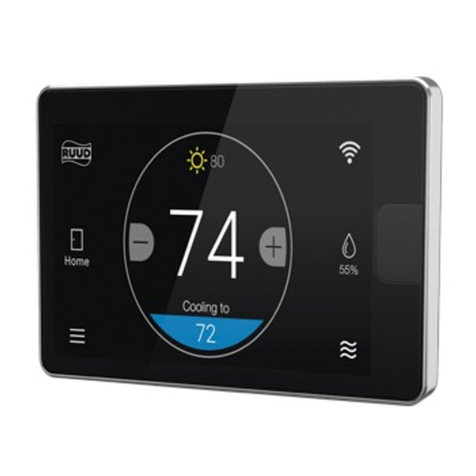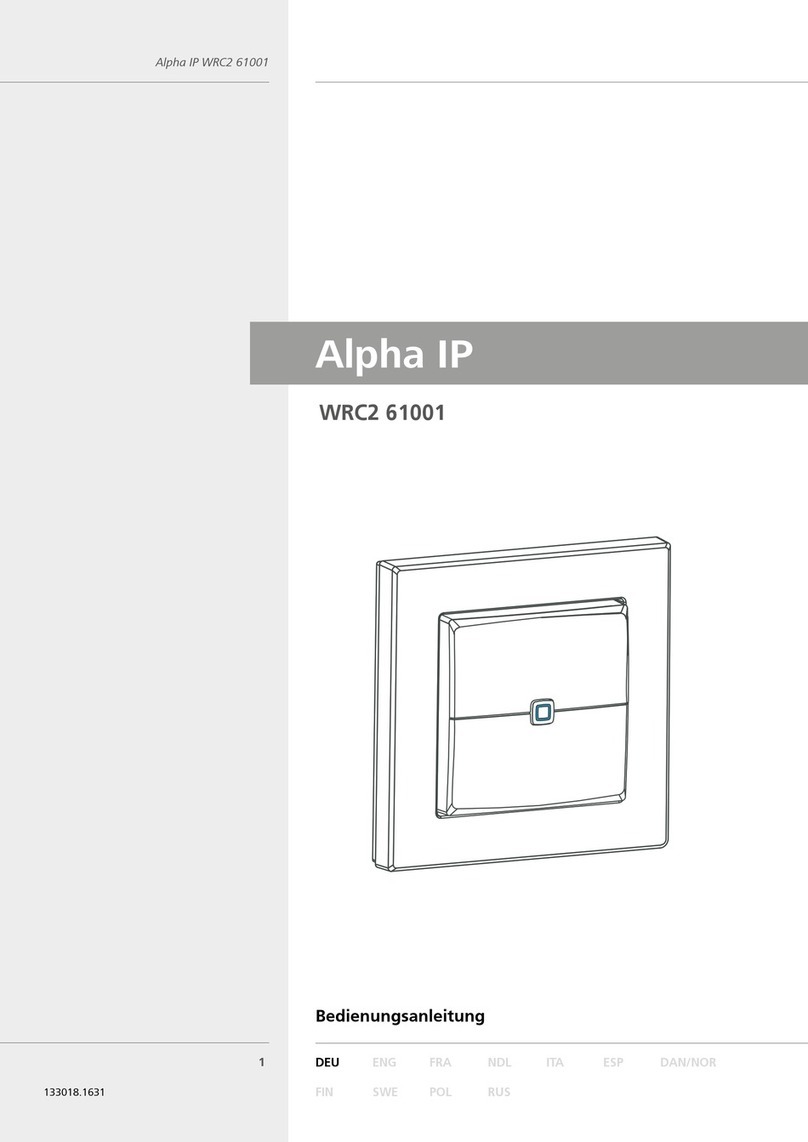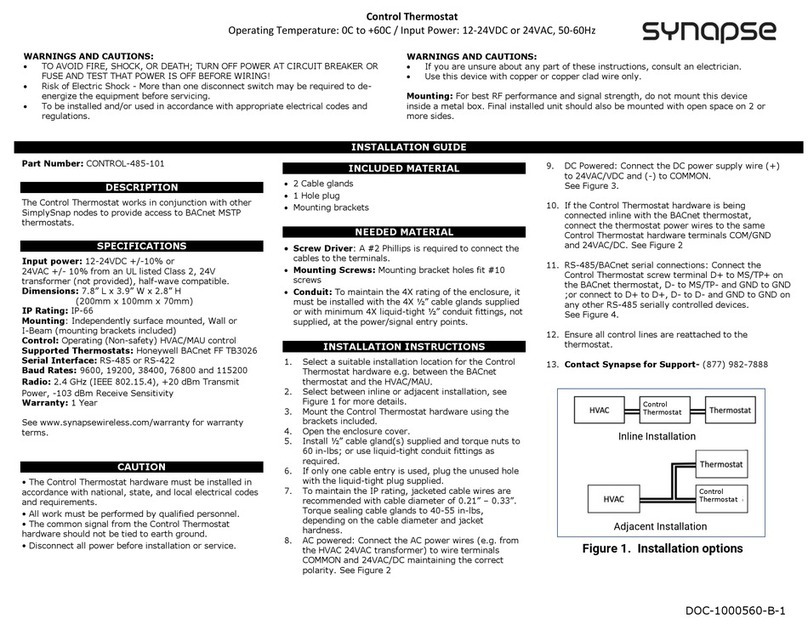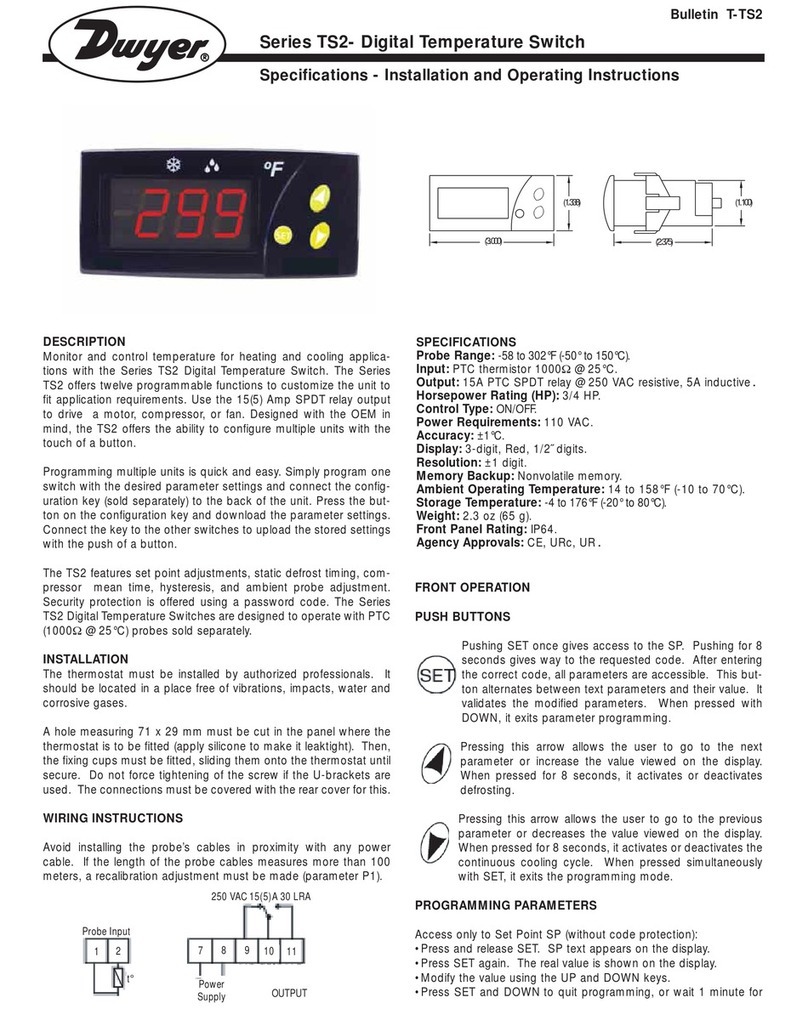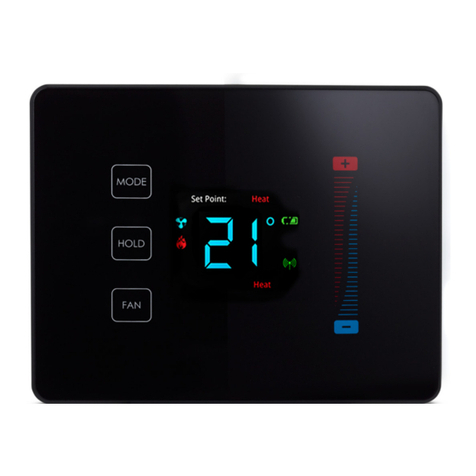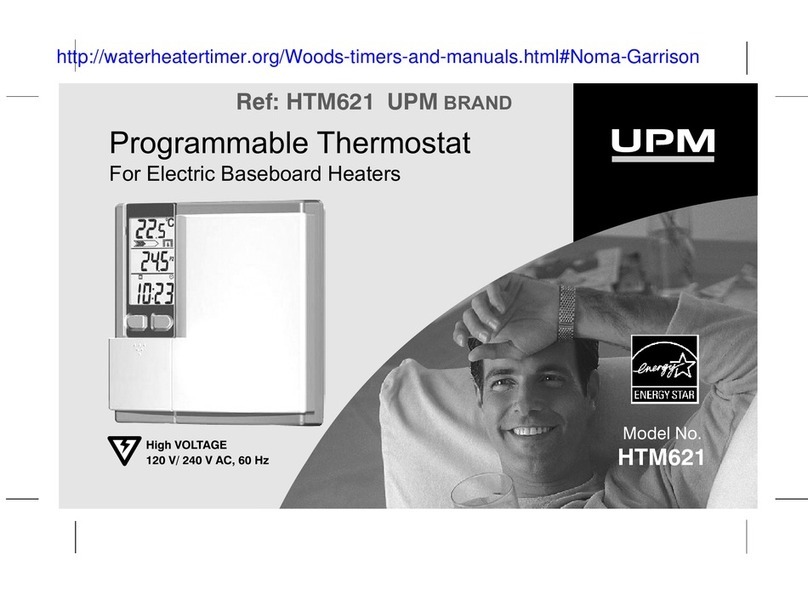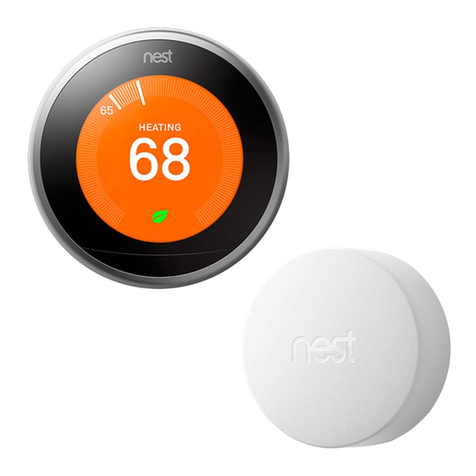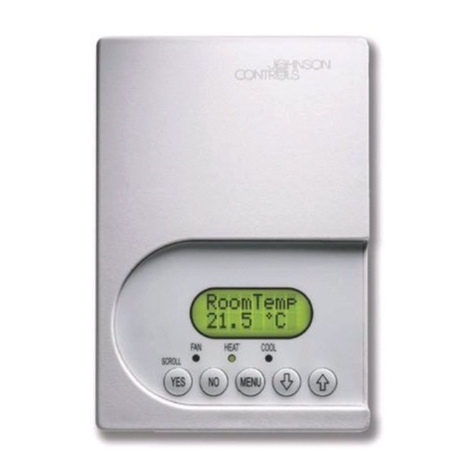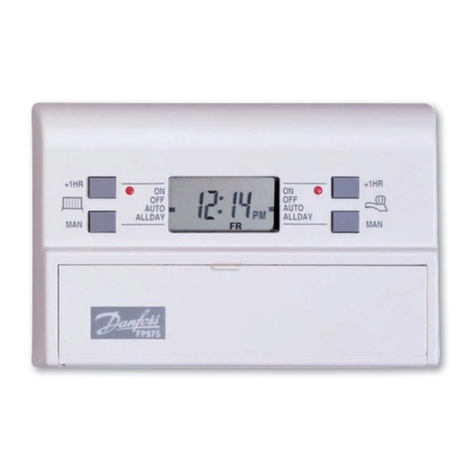Nextron Tracemate-277V User manual

TRACE
MATE-277V
OPERATOR’S MANUAL
ELECTRONIC THERMOSTAT
ISO 9001 Registered

TRACE
MATE-277V
Contents
1 Product Overview .................................................................................................................... 1.1
Introduction........................................................................................................................................................................ 1.1
Conventions....................................................................................................................................................................... 1.1
Features and Benefits....................................................................................................................................................... 1.1
Specifications .................................................................................................................................................................... 1.2
2 Installation................................................................................................................................ 2.1
Unpacking the Controller.................................................................................................................................................. 2.1
Control Module .................................................................................................................................................................. 2.1
Mounting the Controller .................................................................................................................................................... 2.3
Wire Sizing ........................................................................................................................................................................ 2.3
Conduit and Cabling ......................................................................................................................................................... 2.3
Power Wiring ..................................................................................................................................................................... 2.3
Heater Wiring .................................................................................................................................................................... 2.3
Ground Connection........................................................................................................................................................... 2.3
RTD Sensor Wiring ........................................................................................................................................................... 2.3
Alarm Wiring ..................................................................................................................................................................... 2.4
3 Applications ............................................................................................................................. 3.1
Mechanical Thermostat Replacement ............................................................................................................................. 3.1
Alarm Annunciator ............................................................................................................................................................ 3.1
Switching Requirements................................................................................................................................................... 3.1
4 Operation ................................................................................................................................. 4.1
Alarms................................................................................................................................................................................ 4.1
Status Indicators ............................................................................................................................................................... 4.1
Alarm Reset....................................................................................................................................................................... 4.1
Heater Setpoint and Alarm Setpoints ............................................................................................................................. 4.1
5 Testing...................................................................................................................................... 5.1
Troubleshooting/System Integrity.................................................................................................................................... 5.1
Calibration ......................................................................................................................................................................... 5.1
Ground Fault Testing ........................................................................................................................................................ 5.1
Repairs............................................................................................................................................................................... 5.2
Warranty ....................................................................................................................... Back Cover

TRACE
MATE-277V
1.1
Product Overview
Introduction
TheTraceMate-277V solid state heat tracing control is an
electronic thermostat designed to maintain a singleheater
at a desired setpoint temperature. It is suitable for use
with mineral-insulated, self-regulating or constant-
wattage cable in applications such as freeze protection,
process control and instrument tracing. TheTraceMate-
277V is intended for indoor or outdoor installation in
ordinary or class 1, division 2 hazardous locations.
TraceMate-277V offers manyadvantages over other heat
tracing control schemes, which generally usesome
combination ofmechanical thermostats, custom-built
panels or programmable controls toprovide control,
monitoring and alarm functions. Wiring costsare mini-
mized bymounting the control in close proximityto the
heat tracing cable and pipe.ANEMA4X enclosure and
wide temperature range electronic components are used to
make mounting possible in most locations. Temperature
sensing is achieved bymounting a 100 ohm platinum
(DIN 43760) RTD sensor on the pipe. Heater current is
controlled bya solid state switch rated 30A. The
temperature setpoint is digital for fast non-ambiguous
setting over a wide range. Maximum system reliabilityis
obtained from a comprehensive alarm package which
includesindicators for quick fault identification anda
groundfault trip tominimize fire hazards.
Bycombining the control, system monitoring and testing
requirements ofa heat trace control system into a general
purpose control, the TraceMate-277V makes it possible to
significantly upgradesystems at low installed cost. In
addition, it is very flexible in its application to adapt to
specific user requirements.
Conventions
Thefollowingconventionsareusedinthismanual:
Features and Benefits
Requirements TraceMate-277V Features
Te m p e ra ture
Control
*
*
*
*
0-511°C/0-511°F setpoint
Non-ambiguous, digital temperature
setpoint
100 ohm platinum RTD sensor
3-wire, lead resistance compensation
System Fault
Alarms
*
*
*
*
*
*
Breaker left off or tripped
Heater continuity or low current
Ground fault trip
Low temperature
High temperature
Broken sensor
Early Warning
*
*
*
Tracecheck exercises dormant
systems every 24 hours for early
warningtopreventshutdowns
Status indicators show cause of
alarms
Separate fail-safe localand remote
alarms
Remote
Monitoring *
*
Form C alarm dry contact output for
alarm indication
LED Alarm indicator viewable on
door
Hazardous/
Ordinary Area
Mounting
*
*
*
*
CSA approved for ordinary or Class
1, Division 2, Grps A,B,C,D
hazardous area
-40° to +50°C operating range
30 amps @277VAC rating
Weatherproof, Nema-4X enclosure
Easy retrofit replacement for
mechanical thermostat
Low Installed
Cost
*
*
*
*
Competitively priced
Self contained, no control panel to
build
Ground fault trip eliminates expensive
ground fault circuit breaker
Standard model simplifies spare
parts stocking

1.2
TRACE
MATE-277V
Product Overview
Temperature Range
Range: -50°C to 500°C, -58°F to 932°F
Hysteresis: ±2°C, ±3.2°F
Absolute Accuracy: ±2.5°C, ±4.5°F
Repeatability: ±1°C, ±1.8°F
RTD: 100 ohm platinum, 3-wire 20 ohms
maximum lead resistance
Heater Switching
Installaton/Overvolatge CAT. III; Pollution Degree 2
Configuration TM-1SIH1-E5-RTD-277V Single-pole
TM-1DIH2-E5-RTD-277V Dual-pole
Dual SCR, one per phase
Ratings: TM-1SIH1-E5-RTD-277V 277Vac @ 30
amps
TM-1DIH2-E5-RTD-277V 277VAC
@30amps
250 amp 1/2 cycle inrush
Line Frequency 50 or 60Hz
Control Power
Installaton/Overvolatge CAT. III; Pollution Degree 2
Power Requirements Control power from heater voltage
TM-1SIH1-xx 277VAC, 10VA
TM-1DIH2-xx 277VAC, 10VA
Protection Control power from heater voltage
protected by non-replaceable 2A, time
lag, 350 VAC fuse
MOV transient protection and RC
snubber
User Interface
Heater Setpoint 12 position dip switch
Reset/Heater Test dip switch
Panel Indicators Power on
Heater on
Low temperature alarm
High temperature alarm
Current fail alarm
Ground fault trip alarm
RTD fail alarm
Environment
Approvals: CSA NRTL/C and FM
Class I, Div.2, Groups A,B,C,D
Class I, Zone 2, Groups IIC
Operating Range: TM-1SIH1-xx: -40°C to +50°C
TM-1DIH2-xx: -40°C to +50°C
Heater current derated
Conformal Coating: Boards conformal coated for hostile
environments. Altitude: 0-2000m
User-Definable Options
Heater Setpoint:
Low Temperature Alarm Setpoint:
High Temperature Alarm Setpoint: 0°C-511°C, 1°C steps
0°F-511°F, 1°F steps
Temperature Units: 0°C or °F
Current Fail Alarm Setpoint: 0.0A-30.0A, 1 A steps
Ground Fault Trip Alarm Setpoint: 0mA-511mA, 1 mA steps
Enclosure
Type: E5: Nema-4X steel, painted black
Size: TM-1SIH1-xx: 8”Hx6”Wx4”D
TM-1DIH2-xx: 10”Hx8”Wx4”D
Features: Quick release latches to open door
One 3/4” conduit knockout for power
and two 1/2” conduit knocks for RTD
and signal wiring.
Alarms
Installaton/Overvolatge CAT. II; Pollution Degree 2
Low Temperature: Actual temperature < low temperature
alarm setpoint
High Temperature: Actual temperature > high temperature
alarm setpoint
Current Fail: Heater current < current fail alarm
setpoint
Ground Fault Trip: Ground fault current > Ground fault trip
alarm setpoint
RTD Fail: RTD Open, RTD Short
Hardware: No incoming voltage
TraceCheck: Current Fail Alarm
Configurationt: NC/NO Contacts
Alarm Output Rating: Form C dry contact: 30Vdc/0.1A
LED Indicator: 6VDC/50mA
Alarm Function
Temperature: Low Temperature Alarm
High Temperature Alarm
Current: Current Fail Alarm
Ground Fault Ground Fault Trip
Hardware RTD Open, RTD Short
Specifications
Heater Current Rating
1 and 2-Pole Switching
0
5
10
15
20
25
30
35
-10 0 10 20 30 40 50
Ambient Air Tem p (°C)
Heater Current (Amps)
1-Pole
2-Pole

TRACE
MATE-277V
2.1
Chapter 2
Installation
Unpacking the Controller
Check the shipping cartons for damage, or other signs of
rough handling or abuse. If damaged, notify the shipping
carrier at once.
Carefullyremove theTraceMate-277V from the shipping
box.
Inspectfaceplatefor shippingdamageand check
electronics for loose wiring or damage. Report any
damage to the carrier at once.
Control Module
See Figure 2.1 TraceMate-277V Controls and Indicator
Layout to locate the following:
Switchesand Jumpers
•S1-9Setpoint Number:
S1-9 consists of9 switches.They are S1, S2, S3, S4,
S5, S6, S7, S8 and S9. These 9 switches generate a
Setpoint Number in a range of 0-511. The exact value
of this Setpoint Number equals the sum of the
contributions by each switch. If a switch is in OFF
position, its contribution is zero. Ifit is in ONposition,
its contribution equals the value labeledon the board.
Ex. 1: If all 9 switches are in the ON position,
SetpointNumber=1+2+4+8+16+32+64+128
+256=511.
Ex. 2: Ifonly switches 4 and 16 are in the ON position,
SetpointNumber=0+0+4+0+16+0+0+0+0
=20.
•S10Temperature Units:
°C if S10 is on °C side.
°F if S10 is on °F side.
•S11RESET: Latched “Current fail” or “Ground Fault
Trip” alarms are cleared when S11 is switched towards
the RESET side momentarilyif the alarm conditions no
longerexist.
•S12TEST: Manuallyforces heater on when S12 is on
TEST side. Noeffect if the ground faulttrip is active.
•JP1Setpoint Configuration:
LT: Setpoint Number generated byS1-9 is interpreted
as lowtemperature alarm setpoint in °C or °F.
HT: Setpoint Number generated by S1-9 is interpreted
ashigh temperature alarm setpointin °C or °F.
GF: Setpoint Number generated by S1-9 is interpreted
as ground fault trip alarm setpoint in mA.
AMP: Setpoint Number generated by S1-9 is divided
by 10 and interpreted as current fail alarm setpoint in
A.
SP: Setpoint Number generated byS1-9 is interpreted
as heater setpoint in °C or °F.
NONE: Setpoint Number generated by S1-9 has no
effects on any setpoints.
Warning - The ground fault trip function is
intended for equipment protection only and
should not be used in place of ground fault
protection for personnel protection where
this is required.
There are no consumable components contained in any of
the models covered in this manual.
There is no cleaning requirements for anyof the modules
covered in thismanual.
Terminals
Refer to Figure 2.2 Typical Wiring Diagram, for
power, heater and RTD field connections.
•T1Form C Alarm Contacts: Both NO (terminals 10
and 11) and NC (terminal 12 and 11) are rated
277Vac@0.5A and 30Vdc@0.1A.
•T2Alarm Light Output: The output is configured as
normallyclosed. Output is rated 6 Vdc @ 50 mAfor an
LEDtype lamp (terminals 8+ and 9-).
•T3RTD Input: 3 wire RTD input. Lead resistance
compensated. (terminals 5,6,7).
•T4Ground Stud.
•T5Heater Power Input: 277VAC/30Amax for both
TM-1SIH1-xx andTM-1DIH2 (terminals 1 and 2).
•T6Heater Power Output:30Amax (terminals 3and 4).
Status Lights:
•L1HTRON: Light is on calling for heat.
•L2RTD FAIL: Light is on when controller detects
open or short RTD inputs.
•L3LO TEMP: Light is on when controller detects a
lowtemperature alarm.
•L4HI TEMP: Light is on when controller detects a
hightemperaturealarm.
•L5AMP FAIL: Light is on when controller detects a
current fail alarm.
•L6GF: Light is on when controller detects a ground
fault trip alarm.
•L7PWR ON: Light is on when control power is
present.
Warning - During installation, disconnect
power supply.
Warning - The operator of this instrument
is advised that if the instrument is used in a
manner not specified in this manual, the
protection provided by the equipement may
be impaired.

2.2
TRACE
MATE-277V Chapter 2
Installation
Figure 2.1 TraceMate-277V Controls and Indicators
Figure 2.2 Typical Wiring Diagram

TRACE
MATE-277V
2.3
Chapter 2
Installation
Mounting the Controller
Mount the control panel with Unistrut brackets using 3/
8” bolts. The Unistrut (or equivalent) mounting allows
air circulation to cool the heat-sink. This is important to
ensure proper operation of the TraceMate-277V.
Mounting dimensions are shown in Figure 2.5.
Wire Sizing
Conduit and Cabling
TraceMate-277V comes with one 3/4” and 1/2” conduit
knockouts located on the bottom of the enclosure.
Conduit hubs should be NEMA-4X rated, such as T&B
H050-0.5 and H075-0.75 or Myers equivalent, to main-
tain a watertight seal. Unused knockouts should be sealed
using NEMA-4Xrated seals.
PowerWiring
The power input terminals supply power to both the heat
trace and controller. Size power input wires appropriately
tothe breaker size andmaximum ambient operating
temperatures. Maximum breaker size is 30A. Connect
power wires toinput terminals 1 and 2. SeeFigure 2.2.
The breaker should be placed as close as possible to the
TraceMate-277V.
The RTD probe is delicate and should not
be bent or used as a tool to puncture
insulation.
Wiring methods should comply with Canadian
Electrical or National Electrical Code and
local codes. Power and signal wires should not
be run in the same conduit system. Wiring
should be rated at least 90 °C, 300V Min.
Wire Size (AWG) Current Load (A) Max. Ambient
Temperature (°C )
63050
83040
10 24 50
12 16 50
The supply voltage must be 277VAC forTM-
1SIH1-E5-RTD-277V ( Single-pole ), TM-
1DIH2-E5-RTD-277V ( Dual-pole ) and rated
voltage range of the heat trace cable.
Wiring methods must conformto Class 1,
Division II or Class 1, Zone II requirements.
Heater Wiring
Connect heatingcable wiring to terminals 3 and 4.See
Figure 2.2. If the heating cable has a braid, it should be
terminatedtothe ground studusing a ring terminal
suitable for #10 stud.
Figure 2.3 GroundConnection
GroundConnection
Connect the controller grounding stud directlytoa ground
bus using the shortest, practical path. Use a tinned copper,
braided bonding cable such as Belden 8660. As a guide-
line, the ground cables should beminimum 96 strands,
number 34AWG each.
To install the ground connection, remove the outside nut,
washer and #8 ring lug provided on the ground stud.
Crimp theground cableonto thering lugand re-assemble
onto theground stud using the washer and nut.
Figure 2.4 RTD Mounting
RTD Sensor Wiring
RTD sensors should be 3-wire, 100 ohm, platinum to DIN
standard 43760. Mount the RTD element on the pipe,
away from the heat trace and 30° to 45° from the bottom
of the pipe. The total circuit resistance per conductor
from the RTD to the control panel must be less than 10
ohm. Exceeding this resistancewill result in a non-linear
temperature measurement. Beldon cable 8770 or
equivalent allows RTDs to be placed up to 1,000 feet
from the control panel. Complete all RTD wiring accord-
ing to Figure 2.2 Typical Wiring Diagram.

2.4
TRACE
MATE-277V Chapter 2
Installation
You must install the RTD sensor on the pipe surface or
thermal well before the pipe insulation to ensure proper
thermal contact.The RTD position should be 180° from
the electric heat trace cable which is the coldest spot of
thepipe.TheRTDsensormaybesecuredtothepipeby
fiber-glass tape. Ifadditional wiring is required for the
RTD, shielded 3-lead wire sized 18 or 20AWG must be
used for the RTD sensor to minimize the effects of noise
pickup.Atypical RTD installation is shown in Figure 2.4.
Alarm Wiring
TraceMate-277V has a form c dry alarm and an active
alarm output for driving an LED alarm indicator. The
alarm LED output is configured to turn on the alarm
indicator when there is no alarm. Refer to Figure 2.2for
alarm output terminals.
The form c dry alarm contact is rated 0.1A 30Vdc.
The alarm LED output is rated 6Vdc, 50mA. It can drive
a 6Vdc LED indicator.
These alarm contact and output are designed as interface
to annunciator, PLC, DCS, or panels.
Figure 2.5 Enclosureand Mounting Dimensions
Warning - Explosion Hazard - Substitution
of components may impair suitability for
Class 1, Division 2 or Class 1, Zone 2.
Warning - Explosion Hazard - Do not
disconnect equipment unless power has
been switched off or the area is known to be
non-hazardous.

TRACE
MATE-277V Chapter 3
APPLICATIONS
3.1
Mechanical Thermostat Replacement
Mount the control unit near the pipe being traced in a
location with easyaccess. Replace the thermostat capil-
larytube with an RTD mounted on the pipe and connect
the existing heater and power wires tothe TraceMate-
277V as shown in Figure 3.1.Agreen alarm status light,
visible to maintenance personnel, is connected to the
TraceMate-277V LED alarm output and should always
be on. If the light goes off, the following may have
occurred: (1) bulb burnt out (fail-safe indication); (2) no
control power available; (3) system fault. Examine the
LEDs inside the TraceMate-277V to determine the cause
of the alarm.
Advantage of this scheme over mechanical thermostats
is: easy setpoint adjustment and early warning of system
faults with TraceCheck system exercising every 24 hours
and rapid fault diagnosis in the event of a problem.
Alarm Annunciator
If an alarm annunciator or programmable controller is
available, terminal 10, 11 & 12 can be used as a low cost
digital interface. These terminals are form c dry con-
tacts. A separate voltage source must be connected across
these terminals as shown in Figure 3.2 for the annuncia-
tor to sense the alarm logic.
Switching Requirements
Two different TraceMate-277V models are available to
accommodate different power configuration of electric
heat trace. The single pole switching model is used for
phase to neutral power feed. The dual pole switching
model is used for phase to phase power feed. Two SCRs
are used in this model to ensure both lines are switched
off. Not onlyis this an electrical code requirement, but to
ensure both connections to theheater are not hot when the
controller is not calling for heat. This is especially
important for the ground fault function to operate
properlysince switching onlyone line there is a 50%
chance that the heater output is properly tripped.
Figure 3.1 Thermostat Replacement
Figure 3.2 Alarm Annunciator

TRACE
MATE-277V Chapter 4
Operation
4.1
Alarms
When an alarm condition occurs, the form c dry alarm
contact reacts and the corresponding alarm LED comes
on to indicate the cause of the alarm. Fault diagnosis for
these alarms is listed below.
RTD Fail: If the RTD sensor is not connected or shorted,
RTD FAILalarm LED will turn on. Check that the RTD
sensor is properlyconnected. This alarm is not latched
and will be reset as soon as the RTD is properly
connected. In the event ofan RTD failure, the heater
output is turned offto prevent a runawayheating
situation.
LowTemperature: Once the actual temperature is below
thelowtemperaturealarm setpoint, LOTEMPalarm
LEDwill turn on. Thiswill normally indicate that the
heater circuit is not providing enough heat to maintain the
setpoint. When a system is first turned on this alarm may
be activated. It is particularlyuseful in taking corrective
action in freezeprotection systems to prevent a burst
pipe.This alarm is not latched and will bereset as soon as
thealarm condition disappears.
High Temperature: Once the actual temperature is above
the high temperature alarm setpoint, HI TEMPalarm
LED will turn on. This alarm is not latched and will be
reset as soon as the alarm condition disappears.
Current Fail:This alarm is activated when theTraceMate-
277V control calls for heat and a heater current less than
thecurrent fail alarm setpoint flows. Either the continuity
of the wiring and heat tracing cable is defective or a very
small heater is being switched. In order to detect faults on
dormant systems with the TraceCheck feature, which
turns on the heaters for several seconds every 24 hours,
this alarm is latched. Thus, once the condition is detected,
thealarmwill remain on until theTraceMate-277Vis
reset.
GroundFaultTrip:This alarm is activated when the
groundfault currentis abovethe groundfault tripalarm
setpoint.A ground fault is a current to ground caused by
moisture, corrosion or insulation breakdown. Often the
amount ofground fault current is not enough totrip the
heater circuit breaker but could result in a serious fire
hazard, especiallywith self-regulating cable.
When a ground fault is detected, the heater will be
switched off, even if the control is calling for heat.This
eliminates the needfor an expensive groundfault circuit
breaker. Largeground fault currentswilltrip theheater
circuit breaker, so an intentional time delayis allowed for
thebreaker to clear high fault currents,which canoccur
on solidly grounded systems.
Since the heater maybe shut offafter a ground fault, it is
very important that the alarm outputs be used so
corrective action can be taken quicklyenough to prevent
a process shutdown due to the loss of heat to a pipe.
Ground fault detection only works with resistance or
solidlygrounded systems. Ifthe system is ungrounded, it
must be grounded or an artificial ground must be created
by means ofa zip-zag transformer. Once a ground fault
condition is detected, it remains latched until it is reset.
Status Indicators
Power On Indicator: When incoming voltage is applied
to the TraceMate-277V, the green PWR ON indicator
LED should be on. If this LED is not on, check that the
appropriate voltage is present byconnecting a meter
across terminals 1 and 2. If voltage is present and the
LED is off, the controller should be replaced and sent to
the factory for service.
Heater On Indicator: Whenever the heater is on, the green
HTR ON indicator LED will be on. This is useful for
checking correct operation of the control. Ifthe ground
fault alarm light orRTD fail alarm light ison, the heater
will not switch on even if the actual temperature is below
thesetpoint.
Alarm Reset
The low/high temperature and RTD fail alarms reset as
soon as the condition disappears. The ground fault trip
and current fail alarm are latchedalarms. Alatched alarm
will remain even if the alarm condition disappears. To
reset the latched alarms, remove incoming power for a
few seconds byopening and reclosing the circuit breaker.
Provided the alarm conditions are no longer present, the
alarms should all be reset when power is re-applied to the
TraceMate-277V. It is also possible to reset the latched
alarms bymomentarily switching S11 towards its ON
position ( refer to Figure 2.1 ) even ifthe TraceMate-
277V is at control with power applied.
HeaterSetpoint andAlarm Setpoints
As stated in chapter 2, five setpoints can be adjusted by
properly setting up S1-9 and JP1 ( refer to Figure 2.1 ).
S1-9 consisits of9 switches. They are S1, S2, S3, S4, S5,
S6, S7, S8 and S9. These 9 switches generate a Setpoint
Number in a range of 0-511. The exact value of this
Setpoint Number equals the sum ofthe contributions by
each switch. Ifa switch is in ON position, its contribution
tothe Setpoint Number equals its labelled value on the
board. Otherwise, its contribution is zero. For example, if
all 9 switches are in ON position, Setpoint Number =
1+2+4+8+16+32+64+128+256 = 511. If only switches
S3 and S5 are in ON position, Setpoint Number =
0+0+4+0+16+0+0+0+0 = 20.
Depending on the jumper position ofJP1, the Setpoint
Number generated by S1-9 can beinterpreted as either
heater setpoint, or lowtemperaturealarm setpoint, or high
temperaturealarm setpoint,orgroundfault tripalarm
setpoint, or current fail alarm setpoint.

TRACE
MATE-277V Chapter 4
Operation
4.2
Heater Setpoint: If the jumper on JP1 is at SP position,
the Setpoint Number generated by S1-9 is interpreted as
the heater setpoint. Whether the setpoint is in °C or °F
depends on the position of S10 ( refer to Figure 2.1 ).
The factorydefault value is 20°C.
LowTemperature Alarm Setpoint: Ifthe jumper on JP1 is
at LT position, the Setpoint Number generated by S1-9 is
interpreted as the low temperature alarm setpoint in °C or
°F. The factory default value is 5°C.
High TemperatureAlarm Setpoint: If the jumper on JP1
is at HT position, the Setpoint Number generated byS1-9
isinterpretedas thehigh temperaturealarm setpoint in °C
or °F. The factory default value is 100°C.
Ground Fault TripAlarm Setpoint: If the jumper on JP1
is at GF position, the Setpoint Number generated byS1-9
isinterpretedas theground fault trip alarm setpoint in
mA. The factory default valueis 30 mA.
Current FailAlarm Setpoint: Ifthe jumper on JP1 isat
AMPposition, the Setpoint Number generated byS1-9 is
divided by10 and interpretedas the current fail alarm
setpoint in A. The factorydefault value is 0.3 A.
NONE: If the jumper on JP1 is at NONE position, the
Setpoint Number generated byS1-9 has no effects on
setpoints.
Once adjusted, all these setpoints will be saved in
EEPROM which means that their values will not be
changed even after power off.

TRACE
MATE-277V Chapter 5
TESTING
5.1
Troubleshooting/SystemIntegrity
A major concern in heat tracing is knowing that the
control and heater cableare functioning normally. On
systems that sit idle for long periods, such as freeze
protection, faults usuallyshowup when the system is
needed most. Users often perform an annual check on
mechanical thermostats toensurethat problems have not
developed. This is a tedious task because the controls are
often high offthe ground in inaccessibleareas.
Since the TraceMate-277V control uses an RTD, it can be
mounted in a convenient ground level location near other
controls for easy access. Indicator lights for HEATER ON
and POWER indicate the system status. If the RTD sensor
or wiring goes open/short circuit, the NO SENSOR LED
comes on indicating a fault. For this condition the actual
temperature output indicates a value out of the
temperature measurement range, i.e. [-50°C-500°C] or
[-58°F-932°F].
The control can be forced on or off easily by changing the
heater setpoint switches to be above or below the actual
processtemperature, noting theHEATER ON LED and
heater current with a clamp-on ammeter.
Calibration
Although the TraceMate-277V control isconstructedwith
precision components and should give long service
without anyrecalibration necessary, users however may
wish to perform periodic calibration checks.When the
TraceMate-277V control isfirst installed, or for periodic
maintenance checks, system operation can be verified by
adjusting the heater setpoint dip switch 2°C aboveand
below a known temperature on the RTD input to see if the
heater turns on and off . For example, if the RTD input
temperatureis 25°C, setting the heater setpoint to27°C
will force the heater on and conversely a 23°C setpoint
will force the heater off.
By substituting a known resistor value for the RTD sensor
and looking up the equivalent temperature in tables 5.1
and 5.2, the calibration accuracyof the control can be
verified. This can be done in the field without removing
the control using a resistance simulator box and a quality
digital multimeter.
Disconnect the incoming RTDwiresand connect a
resistancebox. Simulate an RTD temperature using the
variable resistor or decade box and set the heater setpoint
dip switch 2°C above the simulated temperature. The
heater LED should turn on. Setting the heater setpoint dip
switch 2°C belowthe simulated temperature, heater LED
should turn off.
Table 5.1 Resistance versus Temperature in °F
(DIN 43760 RTD)
°F R (ohms) °F R (ohms) °F R (ohms)
-40 84.27 160 127.50 360 169.29
-30 86.47 170 129.62 370 171.34
-20 88.66 180 131.74 380 173.39
-10 90.85 190 133.86 390 175.43
0 93.03 200 135.97 400 177.48
10 95.22 210 138.08 410 179.51
20 97.39 220 140.18 420 181.55
30 99.57 230 142.29 430 183.58
40 101.74 240 144.38 440 185.61
50 103.90 250 146.48 450 187.63
60 106.06 260 148.57 460 189.65
70 108.22 270 150.66 470 191.67
80 110.38 280 152.74 480 193.68
90 112.53 290 154.82 490 195.69
100 114.68 300 156.90 500 197.69
110 116.83 310 158.97
120 118.97 320 161.04
130 121.10 330 163.11
140 123.24 340 165.17
150 125.37 350 167.23
Figure 5.1 RTD SIMULATION

TRACE
MATE-277V Chapter 5
TESTING
5.2
Table 5.2 Resistance versus Temperature in °C
(DIN 43760 RTD)
°C R (ohms) °C R (ohms) °C R (ohms)
-40 84.27 80 130.89 200 175.84
-30 88.22 90 134.70 210 179.51
-20 92.16 100 138.50 220 183.17
-10 96.09 110 142.29 230 186.82
0 100.00 120 146.06 240 190.46
10 103.90 130 149.82 250 194.08
20 107.79 140 153.58 260 197.69
30 111.67 150 157.32 270 201.30
40 115.64 160 161.04 280 204.88
50 119.39 170 164.76 290 208.46
60 123.24 180 168.47 300 212.03
70 127.07 190 172.16
It is possible to simulate a ground fault by creating a
situation where the current from the two heater terminals
1 and 2 is not equal. As shown in figure 5.2, this is done
byconnecting a resistor across terminals 1 and 4.
Follow these steps totest the ground fault circuit:
1. Turn on incoming power. Set thegound fault trip
alarm setpoint to 30mA ( default ).
2. Turn off incoming power.
3. Connect a resistor between terminals 1 and 4.
This allows ground fault current IGtoflow,
which will be seen bythe ground fault sensor as
a ground fault. Sizethe resistor according to the
table to ensure sufficient ground fault current of
30mA ± 25%.
Heater Voltage 110 240 277 AC Volts
Resistance 2700 6200 6800 Ohms
Wattage 5 10 15 Watts
Voltage Rating 250 500 500 DC Volts
4. Apply power. The ground fault indicator should
come on after a short delay. It should not be
possible to turn on the heater even if the actual
temperature is belowthe setpoint. The
TraceMate-277V acts a ground fault circuit
breaker.
5. Turn off incoming power.
6. Remove the ground fault resistor between
terminals 1 and 4.
7. Re-applypower. All alarm indicators should be
off.
Repairs
In the event of a hardware failure, system operation can
be restored quickly by following this procedure:
1. Turn off incoming heater and alarm power.
2. Ensure that all wires are correctly marked for
the corresponding terminals.
3. Disconnectall wires tothe terminals.
4. Remove any screws holding the TraceMate-
277V controller and return it to the factoryfor
repair.
5. Install a replacement TraceMate-277V control-
ler.
6. Reconnect the wires, apply power and follow
the testing procedure for a new control.
Figure 5.2 GROUND FAULT SIMULATION
Ground Fault Testing

Warranty
The manufacturer warrants each control that it manufactures to be free from
defective material or workmanship for a period of 12 months from date of
purchase.
Under thiswarranty, the obligation of themanufacturer is limited to repairing
or replacing the defective control at itsoption, when returned to the manufac-
turer’s factory with shipping chargesprepaid.
If failure has been caused by misuse, incorrect application or alteration of the
control, thiswarranty will be void.
UNLESS SPECIFICALLY PROVIDED FOR IN WRITING IN THIS WAR-
RANTY, EACH CONTROL IS PROVIDED WITHOUT ANY WARRANTY OF
ANYKIND EITHER EXPRESSED OR IMPLIED. IN PARTICULAR, WITH-
OUT LIMITING THE GENERALITYOF THE FOREGOING, THE FOLLOW-
ING IMPLIED WARRANTIESAND CONDITIONSARE EXPRESSLY DIS-
CLAIMED:
a). ANY IMPLIED WARRANTY OR CONDITION THAT THE CON-
TROL WILL MEET YOUR REQUIREMENTS.
b). ANY IMPLIED WARRANTY OR CONDITION THAT THE OP-
ERATION OF THE CONTROL WILL BE UNINTERRUPTED OR
ERROR FREE;AND
c). ANY IMPLIED WARRANTY OR CONDITION OF
MERCHANTABILITY OR FITNESS FOR APARTICULAR
PURPOSE.
The user shall be made aware that if the equipment is used in a manner not
specified by the manufacturer, the protection provided by the equipment may
beimpaired.

TRACE
MATE-277V
ELECTRONIC THERMOSTAT
P/N: 1501-0013_1 TMII-277V 02/09 Printed in Canada
Nextron Corporation 6120 11th Street S.E., Calgary, Alberta, T2H 2L7, Tel:(403) 735-9555, Fax: (403) 735-9559
Table of contents
Other Nextron Thermostat manuals
